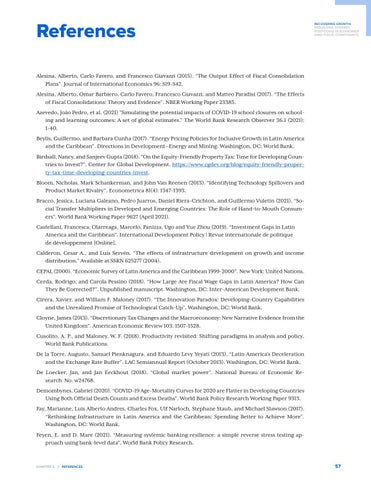References
RECOVERING GROWTH: REBUILDING DYNAMIC POST-COVID-19 ECONOMIES AMID FISCAL CONSTRAINTS
Alesina, Alberto, Carlo Favero, and Francesco Giavazzi (2015). “The Output Effect of Fiscal Consolidation Plans”. Journal of International Economics 96: S19-S42. Alesina, Alberto, Omar Barbiero, Carlo Favero, Francesco Giavazzi, and Matteo Paradisi (2017). “The Effects of Fiscal Consolidations: Theory and Evidence”. NBER Working Paper 23385. Azevedo, João Pedro, et al. (2021) "Simulating the potential impacts of COVID-19 school closures on schooling and learning outcomes: A set of global estimates." The World Bank Research Observer 36.1 (2021): 1-40. Beylis, Guillermo, and Barbara Cunha (2017). “Energy Pricing Policies for Inclusive Growth in Latin America and the Caribbean”. Directions in Development—Energy and Mining. Washington, DC: World Bank. Birdsall, Nancy, and Sanjeev Gupta (2018). “On the Equity-Friendly Property Tax: Time for Developing Countries to Invest?”. Center for Global Development. https://www.cgdev.org/blog/equity-friendly-property-tax-time-developing-countries-invest. Bloom, Nicholas, Mark Schankerman, and John Van Reenen (2013). “Identifying Technology Spillovers and Product Market Rivalry”. Econometrica 81(4): 1347-1393. Bracco, Jessica, Luciana Galeano, Pedro Juarros, Daniel Riera-Crichton, and Guillermo Vuletin (2021). “Social Transfer Multipliers in Developed and Emerging Countries: The Role of Hand-to-Mouth Consumers”. World Bank Working Paper 9627 (April 2021). Castellani, Francesca, Olarreaga, Marcelo, Panizza, Ugo and Yue Zhou (2019). “Investment Gaps in Latin America and the Caribbean”. International Development Policy | Revue internationale de politique de développement [Online]. Calderon, Cesar A., and Luis Servén. “The effects of infrastructure development on growth and income distribution.” Available at SSRN 625277 (2004). CEPAL (2000). “Economic Survey of Latin America and the Caribbean 1999-2000”. New York: United Nations. Cerda, Rodrigo, and Carola Pessino (2018). “How Large Are Fiscal Wage Gaps in Latin America? How Can They Be Corrected?”. Unpublished manuscript. Washington, DC: Inter-American Development Bank. Cirera, Xavier, and William F. Maloney (2017). “The Innovation Paradox: Developing-Country Capabilities and the Unrealized Promise of Technological Catch-Up”. Washington, DC: World Bank. Cloyne, James (2013). “Discretionary Tax Changes and the Macroeconomy: New Narrative Evidence from the United Kingdom”. American Economic Review 103: 1507-1528. Cusolito, A. P., and Maloney, W. F. (2018). Productivity revisited: Shifting paradigms in analysis and policy. World Bank Publications. De la Torre, Augusto, Samuel Pienknagura, and Eduardo Levy Yeyati (2013). “Latin America’s Deceleration and the Exchange Rate Buffer”. LAC Semiannual Report (October 2013). Washington, DC: World Bank. De Loecker, Jan, and Jan Eeckhout (2018). “Global market power”. National Bureau of Economic Research No. w24768. Demombynes, Gabriel (2020). “COVID-19 Age-Mortality Curves for 2020 are Flatter in Developing Countries Using Both Official Death Counts and Excess Deaths”. World Bank Policy Research Working Paper 9313. Fay, Marianne, Luis Alberto Andres, Charles Fox, Ulf Narloch, Stephane Staub, and Michael Slawson (2017). “Rethinking Infrastructure in Latin America and the Caribbean: Spending Better to Achieve More”. Washington, DC: World Bank. Feyen, E. and D. Mare (2021). “Measuring systemic banking resilience: a simple reverse stress testing approach using bank-level data”, World Bank Policy Research.
CHAPTER 2 | References
57


